#Antarctic journal
Explore tagged Tumblr posts
Text






Antarctic Journal: a team of researchers travel to the pole of inaccessibility & find remnants of a failed British expedition 80 years prior. Their journey becomes increasingly dangerous as events chronicled in the journal begin to manifest before them!
14 notes
·
View notes
Text
Why do people go to Antarctica?

Since it's getting colder here, I thought ''Why not watch a movie taking place in the one place on the planet where humans aren't made to live?''. I mean think about it, only animals can survive there, so why in the actual f*ck would anyone want to set foot there? Let's find out.
#currently watching#antarctic journal#남극일기#korean movie#baby it's cold outside#Well duh you're in fucking antarctica
0 notes
Text





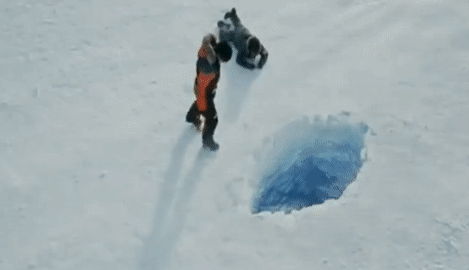

Antarctic Journal (2005) and The Terror (2018) side by side.
#both are good#the journal a bit less so than the Terror but fun nevertheless#I would recommend anyone who likes The terror to watch Antarctic Journal#the terror#the terror amc#james fitzjames#horror#horror edit#survival horror#my stuff#my edits#korean horror#antartic journal
38 notes
·
View notes
Text

Incamys bolivianus was a caviomorph rodent representing an early member of the chinchillid family, with its closest modern relatives being chinchillas and viscachas.
Living in what is now Bolivia and Argentina during the late Oligocene about 27 million years ago, it inhabited an arid open grassland at a time when the area's climate had drastically cooled due to the formation of the Antarctic Circumpolar Current.
It's estimated to have been similar in size to a large modern chinchilla – weighing around 700g (~1lb 8oz) and measuring about 25-30cm long not including the tail (~10-12").
An endocast of the shape of its brain from a near-complete fossil skull shows that it had a well-developed sense of hearing, particularly in vocalization processing, suggesting it may have been a social animal living in groups communicating with complex calls similar to modern chinchillids. It was probably a ground-dweller less agile than its modern relatives, but still capable of fast movements.
———
NixIllustration.com | Tumblr | Patreon
References:
Bertrand, Ornella C., et al. "The virtual brain endocast of Incamys bolivianus: insight from the neurosensory system into the adaptive radiation of South American rodents." Papers in Palaeontology 10.3 (2024): e1562. https://doi.org/10.1002/spp2.1562
Rasia, Luciano L., Adriana M. Candela, and Carola Cañón. "Comprehensive total evidence phylogeny of chinchillids (Rodentia, Caviomorpha): Cheek teeth anatomy and evolution." Journal of Anatomy 239.2 (2021): 405-423. https://doi.org/10.1111/joa.13430
Wikipedia contributors. “Agua de la Piedra Formation” Wikipedia, 06 Jan. 2025, https://en.wikipedia.org/wiki/Agua_de_la_Piedra_Formation
Wikipedia contributors. “Incamys” Wikipedia, 19 Jan. 2025, https://en.wikipedia.org/wiki/Incamys
#science illustration#paleontology#paleoart#palaeoblr#incamys#chinchillidae#caviomorpha#hystricognathi#rodent#mammal#art#chinchillin
141 notes
·
View notes
Text
In March 1842, while sailing in the daring and dangerous Antarctic sea, HMS Erebus and HMS Terror collided with each other while trying to avoid an iceberg. Masts, rigging and all. The collision happened because the two ships wanted their captains to kiss. This academic journal, using new archival records and visions revealed to me in dreams, will discuss—
#*I am thrown overboard before I can say anymore*#rossier#ross expedition#francis crozier#james clark ross#seriously tho WASNT THIS CRAZY?!#amanda speaks
89 notes
·
View notes
Text
A new species of Antarctic dragonfish, Akarotaxis gouldae or Banded Dragonfish, has been discovered in waters off the western Antarctic Peninsula by researchers at William & Mary's Virginia Institute of Marine Science (VIMS). The species, named in honor of the recently decommissioned Antarctic research and supply vessel (ARSV) Laurence M. Gould and its crew, exemplifies both the unknown biodiversity and fragile state of the Antarctic ecosystem. Described in the journal Zootaxa, Akarotaxis gouldae was initially identified through genetic analysis. Larval specimens collected off the coast of Antarctica while trawling for zooplankton were originally thought to be Akarotaxis nudiceps, a closely related dragonfish. However, after comparing their DNA to Akarotaxis nudiceps specimens housed in collections at VIMS, Yale University and the Muséum national d'Histoire naturelle in Paris, France, significant variations in mitochondrial gene regions suggested the larval samples were a species unto themselves.
Continue Reading.
64 notes
·
View notes
Text

in every scene this guy looks like he's narrating the last journal entry of a doomed antarctic expedition and im kind of lowkey obsessed
#cdrama#the double#whatever the fuck him and wanning have going on is the most compelling part of the show to me#compelling =/= endorsement
73 notes
·
View notes
Photo



Happy #WorldPenguinDay!
Images here from Frederick Cook’s Through the First Antarctic Night, 1898–1899, a remarkable journal recounting the highs and (many) lows of the Belgica expedition, including experiencing a night two months long: https://publicdomainreview.org/collection/through-the-first-antarctic-night-1900
116 notes
·
View notes
Text

New SpaceTime out Wednesday
SpaceTime 20250305 Series 28 Episode 28
How the Solar system's journey through Orion may have altered Earth's climate
A new study suggests planet Earth’s climate may have undergone profound change 14 million years ago when our solar system migrated through the Orion star forming region.





Have scientists been wrong about why Mars is red?
A new study suggests the Red Planet’s iconic rusty dust has a much wetter history than previously thought.


Europa Clipper swoops past Mars
NASA's Europa Clipper has successfully completed a close gravity assist flyby of the Red Planet Mars as it continues on its journey to the solar system’s largest planet Jupiter.




The Science Report
The Antarctic Circumpolar Current projected to slow down due to climate change.

New research suggests that it might be time to reassess the current treatment of prostate cancer.
Researchers find that an hour spent in front of screens increases kids' risk of myopia.
Alex on Tech new generative-AI infused Alexa
SpaceTime covers the latest news in astronomy & space sciences.
The show is available every Monday, Wednesday and Friday through Apple Podcasts (itunes), Stitcher, Google Podcast, Pocketcasts, SoundCloud, Bitez.com, YouTube, your favourite podcast download provider, and from www.spacetimewithstuartgary.com
SpaceTime is also broadcast through the National Science Foundation on Science Zone Radio and on both i-heart Radio and Tune-In Radio.
SpaceTime daily news blog: http://spacetimewithstuartgary.tumblr.com/
SpaceTime facebook: www.facebook.com/spacetimewithstuartgary
SpaceTime Instagram @spacetimewithstuartgary
SpaceTime twitter feed @stuartgary
SpaceTime YouTube: @SpaceTimewithStuartGary
SpaceTime -- A brief history
SpaceTime is Australia’s most popular and respected astronomy and space science news program – averaging over two million downloads every year. We’re also number five in the United States. The show reports on the latest stories and discoveries making news in astronomy, space flight, and science. SpaceTime features weekly interviews with leading Australian scientists about their research. The show began life in 1995 as ‘StarStuff’ on the Australian Broadcasting Corporation’s (ABC) NewsRadio network. Award winning investigative reporter Stuart Gary created the program during more than fifteen years as NewsRadio’s evening anchor and Science Editor. Gary’s always loved science. He studied astronomy at university and was invited to undertake a PHD in astrophysics, but instead focused on his career in journalism and radio broadcasting. Gary’s radio career stretches back some 34 years including 26 at the ABC. He worked as an announcer and music DJ in commercial radio, before becoming a journalist and eventually joining ABC News and Current Affairs. He was part of the team that set up ABC NewsRadio and became one of its first on air presenters. When asked to put his science background to use, Gary developed StarStuff which he wrote, produced and hosted, consistently achieving 9 per cent of the national Australian radio audience based on the ABC’s Nielsen ratings survey figures for the five major Australian metro markets: Sydney, Melbourne, Brisbane, Adelaide, and Perth. That compares to the ABC’s overall radio listenership of just 5.6 per cent. The StarStuff podcast was published on line by ABC Science -- achieving over 1.3 million downloads annually. However, after some 20 years, the show finally wrapped up in December 2015 following ABC funding cuts, and a redirection of available finances to increase sports and horse racing coverage. Rather than continue with the ABC, Gary resigned so that he could keep the show going independently. StarStuff was rebranded as “SpaceTime”, with the first episode being broadcast in February 2016. Over the years, SpaceTime has grown, more than doubling its former ABC audience numbers and expanding to include new segments such as the Science Report -- which provides a wrap of general science news, weekly skeptical science features, special reports looking at the latest computer and technology news, and Skywatch – which provides a monthly guide to the night skies. The show is published three times weekly (every Monday, Wednesday and Friday) and available from the United States National Science Foundation on Science Zone Radio, and through both i-heart Radio and Tune-In Radio.
#science#space#astronomy#physics#news#nasa#astrophysics#esa#spacetimewithstuartgary#starstuff#spacetime#hubble telescope#hubble
10 notes
·
View notes
Text
Excerpt from this story from EcoWatch:
A new report from a team of international scientists has revealed harsh realities on Earth, with 25 of 35 planetary vital signs reaching record extremes. Without immediate action, scientists warn that these extremes could threaten life on Earth.
In the new study, published in the journal BioScience, scientists presented a stark look at the state of the climate crisis.
“We are on the brink of an irreversible climate disaster. This is a global emergency beyond any doubt. Much of the very fabric of life on Earth is imperiled. We are stepping into a critical and unpredictable new phase of the climate crisis,” the scientists wrote.
Scientists use 35 different planetary vital signs to track the effects of climate change, including human population, global tree cover loss, meat production per capita, energy consumption, carbon dioxide emissions, ice mass changes, glacier thickness and more.
Twenty-five of these vital signs are already breaking records, including human population, coal and oil consumption, ruminant livestock populations, U.S. heat-related deaths, carbon emissions, methane levels, fossil fuel subsidies, ocean heat content changes, ocean acidification, glacier thickness and tree cover loss, among others.
According to the scientists, the human population is increasing by around 200,000 people per day, while ruminant livestock populations are increasing by around 170,000 animals per day. They also found that fossil fuel consumption increased 1.5% in 2023.
A separate report, the 2024 Forest Declaration Assessment, recently confirmed a decrease in tree cover, with 6.3 million hectares of land deforested in 2023.
Although the scientists did find that renewable energy consumption increased in 2023, renewables are still not overtaking fossil fuel demand enough to limit severe impacts of climate change.
Further, scientists warned that atmospheric carbon dioxide and methane concentrations have reached record highs, the average surface temperature of the Earth is at a record high, ocean acidity has broken records, ocean heating is at an all-time high, and global sea levels are at the highest amounts ever recorded.
On the other hand, Greenland and Antarctic ice masses have reached record lows, and the average global glacier thickness is at an all-time low.
We are already seeing the devastating impacts of these vital signs hitting extremes, with a 117% increase in heat deaths in the U.S. from 1999 to 2023. Last year, areas across Asia experienced deadly heat waves that killed thousands of people, the report authors warned.
Now, the U.S. is facing two back-to-back hurricanes amid rising ocean temperatures, which have nearly doubled in the past two decades, a recent report from EU Copernicus found.
31 notes
·
View notes
Text
Antarctic Food
Below you will find my account of eating at McMurdo, but PBS did a whole special on it which has more privileged access and, like, moving pictures and stuff. I highly recommend watching that if you're at all interested in the food question.
As other pleasures in life are restricted or eliminated, food gains significance beyond mere nutrition. When removed from the comforts and diversions of civilisation for months or years at a time, polar explorers had to pay particular attention to the culinary side of their enterprise. Scott learned this the hard way on the Discovery, when their cook was so bad he was sent home after the first year and others took over his job in shifts. Shackleton, on his second visit to Antarctica, brought all sorts of tinned delicacies, and left a lot of them behind in his hut at Cape Royds, which the Terra Nova men would raid on day trips from Cape Evans. Scott was much more careful with his choice of cook on his second expedition, and in his journal he continually praises Clissold's cooking – though Atkinson, writing for a publication he knew no one would read, says that Archer (the ship's cook, who filled in after Clissold was invalided home) was a far superior chef, and made the miserable second winter that much more bearable.
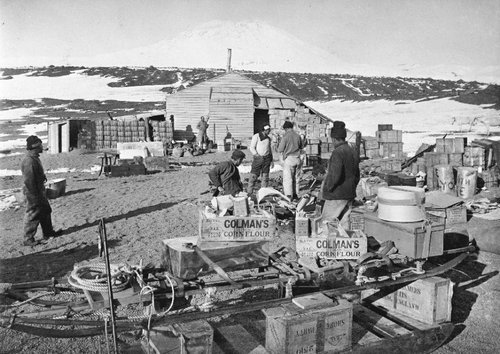
The expeditions of the early 20th Century brought down crates and crates of imperishables – tinned vegetables, powdered milk and eggs, and dry goods like flour, sugar, and tea. These were necessary, of course, but were ultimately supplemental to the core of their diet, which was the produce of Antarctica itself. In fact, in a letter laying out contingency plans if the Terra Nova Expedition were stranded in Antarctica, Scott says not to worry for their safety because the continent provides enough food to keep a party happily fed; they would only be wanting the comforts of a civilised menu. Mostly what the continent provided was seals, whose meat (especially livers) contained enough Vitamin C to stave off scurvy, but penguins and their eggs also regularly passed through the kitchen, and the contents of the marine biologist's net – once properly enumerated and dissected, of course – would often end up in the frying pan. The Notothenia fish was commonly eaten at breakfast, appreciated for its 'sweet' and 'nutty' flavour. Notothenia’s claim to fame is the sugar in its blood that acts as an antifreeze, so this is hardly a surprise.
Thanks to the Antarctic Treaty forbidding the killing of animals for consumption, modern Antarctic larders are not stocked with local wildlife, and as far as I know, no one down there now has tasted the sweetness of Notothenia. They do, however, have the advantage of modern transport and food storage, not to mention a century's worth of advances in the study of nutrition, so the diet of the present-day Antarctican is fresher, healthier, and much more diverse.
McMurdo Station's annual food supply arrives in one lump delivery, every January, on a big cargo ship from California. From the harbour where the Discovery berthed, it goes into climate-controlled storage, either to the dry goods store or to the freezer, which is a whole building off the cafeteria in the main station hub. A freezer, in Antarctica? Why, yes, because food safety regulations require frozen food to be kept at a constant temperature, and the only way to ensure that is to build an enormous manmade freezer in the land of ice and snow. In the summer, temperatures at McMurdo will wander around freezing, so this is entirely practical, but for much of the year, it's actually warmer inside the freezer than outside.
The modern Antarctic commissariat is not entirely divorced from its Edwardian predecessor, though – frozen vegetables taste fresher than tinned, and are more nutritious and palatable, but they are not fresh; powdered milk and powdered eggs are still the status quo. During the summer, perishable groceries – called 'freshies' – come down on the flights from New Zealand, if there is room after the passengers and equipment are loaded. After a month of flight cancellations, fresh apples and oranges are greeted with as much delight as they were on the arrival of relief ships in the Heroic Age, and the appearance of a salad bar in the Galley prompts general rejoicing.
The US Antarctic Program has its roots in the Navy, and McMurdo is still provisioned by one of the big firms that supplies the US military. Having had experience with industrial-scale American catering in California, I had moderate expectations of the quality of food at McMurdo, but it was surprisingly good. One might argue that the excitement of being there and the daily energy expenditure would be a good sauce for anything, and this may be true, but against this I would argue that dry air impedes one's ability to taste – that fact it was so flavourful at all is significant. People kept apologising for the food in the Galley and I kept telling them, earnestly, that it was better than the food in the Disney commissary. They didn't believe me, but I firmly attest this; I ate at Disney on my return journey and have confirmed it by direct comparison. I know they were working with roughly the same quality of ingredients, but the chefs at McMurdo reliably made things delightful to eat, which is more than I can say for the other place. Why this should be is anyone's guess ... Working as a Galley Rat is one of the few ways enthusiasts can get down to the Ice, so it's full of keen, intelligent, and curious cooks, and maybe that rubs off on the food. There are people who come back to tackle the unique challenges of Antarctic cuisine year after year, so maybe they're more experienced and invested in the job. My personal theory is that because they have to eat the food, too, of course they're invested in making it tasty – I suspect the folks behind the counter in LA have much better meals waiting for them when they get home.
Mealtimes follow a strict schedule:
5:30-7:30 Breakfast (many a time I missed the cutoff, woe)
11:00-13:00 Lunch
17:00 to 19:30 Dinner. There was always a portion of the cafeteria serving breakfast food at this time; this was reserved for the night shift workers, who got a reprise of the day shift's dinner for their lunch. If you really liked whatever was served for dinner, nothing could stop you coming around again for another go at midnight.
The one exception to this was Sunday, when a brunch would be served from 10 to 12. The service in the chapel started at 10 as well, and was very weak competition. Brunch was always excellent, and being the single day off, was often where one would meet up with people who were too busy during the week.
If you failed to make a mealtime for any reason, there was always something on offer. A fridge would be stocked with packaged leftovers, sandwiches, and other food-to-go – when I had a day out, I would eat breakfast and then grab my lunch from this fridge. On one occasion, dinner included fried okra (one of my faves, rarely had outside the States) and after stuffing myself with it, I nabbed two or three extra portions and cached them in my dorm room mini-fridge to enjoy later.
In a challenging environment, with a lot of people doing energy-intensive jobs, calories are important. There was only one rule regulating portions: Take what you want, but eat what you take. With a finite amount of food on hand, and delivery only once a year, food waste is anathema – if you need it, then eat it, but do not throw any away.
The menu seemed to originate with whatever presented itself in the enormous freezer, though perhaps in November and December it was dictated more by what remained in it, prior to the new shipment. We didn't suffer for want of variety, though: if anything, we benefited from a surfeit of prawns, including great bowls of them at Sunday brunch. I found myself wondering if the US military had a contract for most of the catch from the Gulf, and how much of their famously inflated budget went into that; I suspect, in reality, the kitchen just hit a seam of prawn in the recesses of the freezer and had to use it up. As a devotee of all shapes of sea bug, I was in seventh heaven, and did my level best to help McMurdo clear the surplus.
Once new food was defrosted and cooked up, it would cascade through various dishes down the week, as leftovers were repurposed to minimise waste. Usually this was successful, but sometimes they had to try a little harder ...

A variety of cuisines were offered, some of which were more successful than others. They seemed to reflect the makeup of the US military, for whom the rations would have been designed. The best dishes were the meat-and-potatoes variety (my minder said that if she were on Death Row, she'd ask for McMurdo Pot Roast for her last meal), Italian, Southern (see above re: okra), and what I assume was Tex Mex – the only misstep on the last count was an almost inedibly hot 'taco soup' which may have been more of a delivery vehicle for leftovers than an intentional dish. The only disappointments were anything attempting to be Asian, and the fish, which, due to the circumstances, was always overcooked. Provision was always made for vegetarians and even vegans, but I can't say I noticed many people adhering strictly to those diets. I suppose if the animals are already dead and in the freezer, there's little difference whether you eat them or not.
There was also, always, pizza. It was left in one of those tiered heated racks like you get at a buck-a-slice takeaway pizzeria, but this was no buck-a-slice pizza, this was McMurdo pizza, and McMurdo pizza is AMAZING. My brother-in-law's cousin went to super legit pizza school in Naples, and gets queues down the street wherever he opens a pizzeria. He makes the best pizza I have ever had anywhere; McMurdo’s wasn't quite as good as his, but it was pretty darn close. It's a testament to how good the rest of the food was that I didn't just have pizza for every meal. The pizza kitchen runs 24 hours a day, and takes orders for pickup from all across the base. If you're flying out to a field camp, it's good manners to take their pizza order and deliver it to them hot and fresh. For all the advances in food technology since the Heroic Age, surely the greatest has to be the McMurdo Pizza.
We were reminded constantly how important hydration was, and the Galley offered a range of liquids at all hours. To my surprise, what looked like a soda fountain offered not pop but fruit juice – grapefruit, orange, cranberry, and apple, though one or more often ran out before the end of breakfast. There were enormous urns of extremely weak coffee – a provision, I supposed, for its diuretic effects – though with 10-hour workdays and very early starts, a little more oomph would have gone a long way. Experienced hands, and those of discerning tastes, brought their own coffee or sourced it somehow from the stores. The kitchenette in the Crary library was full of people's personal coffee-making supplies as they sought a more effective brew.
I had been warned that if I liked tea, I should bring my own; this was a sound warning, as the black tea on offer looked and smelled as though it had been on a shelf for about a decade. What I had not been warned about was that the only 'milk' on hand for one's coffee or tea was, in most places, 'coffee whitener', a ubiquitous Americanism which I'd completely forgotten about (or supressed?) since moving away. For those who've not had the privilege of its acquaintance, this is a blend of margarine, sugar, synthetic vanilla, and titanium dioxide, rendered into a powder by some unknown chemical process and packaged up to pass for milk. (I think it might be illegal in Europe. I've certainly not seen it around.) The Galley had the base's only dispenser of actual mammalian lactation – reconstituted from powdered, of course. If I were to go again, I would bring a small bottle to fill there with 'real' milk, which I could take away for tea purposes elsewhere. There were boxes of UHT milk available for purchase in the shop, and had I been staying longer I might have invested in some, but for just a splash per cuppa, it hardly seemed worthwhile.
The undisputed star of the Galley was the soft serve ice cream dispenser, named Frosty Boy (or Boi), an ancient beast that was such an institution that it was rumoured the USAP had bought another one from a junkyard just for parts. The Thing to Do was, instead of putting milk or coffee whitener in your coffee, to use a dollop of Frosty Boy instead – I'm not sure which end of the dairy/non-dairy spectrum his product was nearest, but it did go well in the coffee, such as it was. More often than not while I was there, Frosty Boy exuded only a watery splutter rather than creamy delight – even when he was working, the product was rather gritty – but I was assured he was just going through a phase, and would be right again soon. I got the impression that if anyone tried replacing the machine with something more reliable, or which produced something more resembling ice cream, there'd be a protest. We shall see if Frosty Boy survives the station revamp, as the NSF seems keen to scrub out any vestiges of character ...
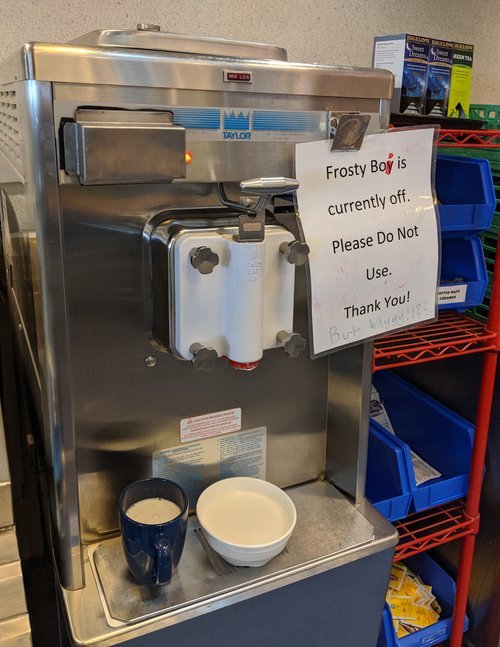
I have brought two things back from the McMurdo Galley, and they're things that go right back to the beginning: powdered milk and powdered egg. Even when I'm near a shop with both in fresh form, it's convenient to have the powdered on hand for recipes. I really only use milk to splash in my tea and coffee, so don't keep a large amount in my fridge, but recipes often call for far more than I have – so instead of making a trip for the extra, I can just mix it up on demand. I've also taken on the Perpetual Yoghurt: McMurdo makes its own yoghurt from its vast reserves of powdered milk, using a bit of the last batch to inoculate the next, and it turns out this is perfectly doable at home, too. Eggs eaten as eggs are better fresh, of course, but when providing structure in a recipe, no one's going to notice if they've been reconstituted, and then I can save my 'real' eggs for when they'll be appreciated. It's a good system, and economical, too. Alas, the pizza isn't as easy to replicate at home ...
For more information on McMurdo food – The Antarctic Sun newsletter put out this podcast: https://antarcticsun.usap.gov/features/4329/ I didn't mention how good the desserts were; I was lucky enough to share my time at McMurdo with Rose McAdoo, who was featured in this story on NPR: https://text.npr.org/779463164
163 notes
·
View notes
Text


[During recovery operations, a number of personal items and belongings were found. The journal pictured above was found waterlogged and barely legible. The entry has been transcribed to plain text for readability.]
EVELYN MARROW
PERSONAL JOURNAL
January 3rd, 19■■
Finally got everything unpacked. It was, in a word, chaos. You'd think that a team of highly educated and professional individuals would have thought to label their luggage, but here we are. Twenty-four hours and three arguments later, almost everything is accounted for. All the important equipment, that is. Greaves somehow forgot his damn toothbrush. Fortunately, Lavalle thought to bring a spare. The angel of mercy descends from the heavens to spare the dental hygiene of a man whose wife probably still packs his lunches.
Since that narrowly-avoided catastrophe, the others have been chatting away. They're excited about the project. I probably should be, too, but something about being stuck in an isolated facility hundreds of miles from human contact seems to numb my sense of adventure. I'm here to do my job, and that's it.
Speaking of my job, it's strange being called “doctor” again. Sure, everyone has their PhDs and research specialties and prestigious fellowships, but I'm the only one here allowed to slap a bandage on someone if they give themselves a papercut. A practical application of education instead of a purely academic one.
Perez hasn't said much since we arrived. Ironic for a communications specialist. Greaves and Bell more than compensate for it, though. I'm thankful that we're merely in the Antarctic and not in a submerged or orbital station somewhere, because if we had limited oxygen, they'd go through it in an hour. It's nothing short of a miracle that anyone can get a word in edgewise
Lavalle's quiet, too. Not like Perez, though. With Lavalle, it's deliberate. She listens when no one thinks she is. Watches people like she's collecting data, even when there's nothing to write down. I caught her staring at the ice through the observation window this morning. Didn’t say anything. Just stood there, still as death. She didn’t blink until I called her name.
When I asked her what she was looking at, she said, “I thought I saw something shift.” She laughed after, but it didn’t reach her eyes.
The thing is, I’d been looking out that same window not ten minutes before.
And I thought the same damn thing.
#Evelyn Marrow#Clara Lavalle#Mina Perez#Rowan Greaves#Elijah Bell#classified#redacted#documents#found footage#ARG#cosmic horror#analog horror#fictional archive#deep lore
7 notes
·
View notes
Text


library haul! don't kill me for the shitty pictures. they've all got borrowing slips taped to the front. titles and authors below the cut.
They Can't Kill Us Until They Kill Us by Hanif Abdurraqib
Nelson: Britannia's God of War by Andrew Lambert
Smoke Gets In Your Eyes: And Other Lessons from the Crematory by Caitlin Doughty (super excited to read this one)
North With Franklin: The Lost Journals of James Fitzjames by John Wilson
The Gates of Hell: Sir John Franklin's Tragic Quest for the North West Passage by Andrew Lambert (almost done with this one. I wanted to like it more.)
The English Vice: Beating, Sex, and Shame in Victorian England and After by Ian Gibson (VERY EXCITED for this one)
The Spectral Arctic: A History of Ghosts and Dreams in Polar Exploration by Shane McCorristine
The Hanging Tree: Execution and the English People 1770-1868 by V. A. C. Gatrell
The Terror by Dan Simmons
White Horizon: The Arctic in the Nineteenth-Century British Imagination by Jen Hill
Erebus: The Story of a Ship by Michael Palin (approaching this one with caution since he's got some nautical inaccuracies and the academic reviews just aren't in favor but i'm making my way through all the polar literature regardless)
Madhouse at the End of the Earth: The Belgica's Journey into the Dark Antarctic Night by Julian Sanction
May We Be Spared to Meet on Earth: Letters of the Lost Franklin Arctic Expedition by Russell A. Potter, Regina Koellner, Peter Carney, and Mary Williamson (really liking this one so far. an emotional read for me personally.)
Voyages of Delusion: The Quest for the Northwest Passage by Glyn Williams
Smallpox in Washington's Army: Disease, War, and Society during the Revolutionary War by Ann M. Becker (Not really liking this one. Super clunky read.)
The Fevered Fight: Medical History of the American Revolution, 1775-1783 by Martin R. Howard
Lotions, Potions, Pills, and Magic: Health Care in Early America by Elaine G. Breslaw
Medicine and the American Revolution: How Diseases and Their Treatments Affected the Colonial Army by Oscar Reiss, M.D.
12 notes
·
View notes
Text
Outposts


In Sonic Icebound, outposts are the umbrella term for any man-made research station, residential community, or other shelter or structure in Antarctica, both on the mainland and its surrounding islands.The first outposts were constructed independently by expeditions that pioneered scientific research on Antarctica. Only a handful of these independent outposts were built, however, as brutal conditions made year-round residence in Antarctica nearly impossible.
Interested in learning more about Sonic Icebound? Visit this document to read up!
Further information on outposts below the cut:
Some time shortly after the ARK raid, G.U.N. and the United Federation commenced an extended joint scientific expedition to the South Pole. Strategic efforts were spearheaded by G.U.N. commander Abraham Tower, with the UF federal government providing funding and logistical support. As part of the program, research stations and residential communities were built en masse at the South Pole, with the expedition’s scope eventually expanding to cover the entire Antarctic continent. The expedition ran on-and-off for seventy-five years.
The expedition carried out research on virtually all aspects of Antarctica, from its climate to its flora and fauna to its potential viability for permanent human life. Researchers meticulously tested every kilometer of the continent, from the windy peaks to the frozen underground.Unbeknownst to the public, the program also collaborated in secrecy with wealthy associates of the Robotniks. Some years later, Eggman would become directly involved in the expedition himself. He agreed to provide logistical support to the venture on the condition that the UF cede territorial control of parts of Antarctica to him personally. Eggman ostensibly planned to build power plants fueled by Chaos energy, but ultimately constructed multiple military bases and Badnik factories instead.
Not long after the Finalhazard incident, G.U.N. conducted what was to be a regularly-scheduled research evaluation. Upon arrival, however, all outposts were completely abandoned. Many of the researchers’ clothes and other personal belongings remained, suggesting the desertion was involuntary or forced. The most recent journal entries from many researchers seem to support this theory, but some earlier entries contradict later ones. Though multiple investigations were conducted over the next several years, the fates of the researchers are still unknown.
(for @sonic-au-collision)
10 notes
·
View notes
Text
Good News - May 8-14
Like these weekly compilations? Support me on Ko-fi! Also, if you tip me on Ko-fi, at the end of the month I'll send you a link to all of the articles I found but didn't use each week - almost double the content!
1. Critically endangered fish with red hands and 'sad toad face' returned to the wild in Tasmania
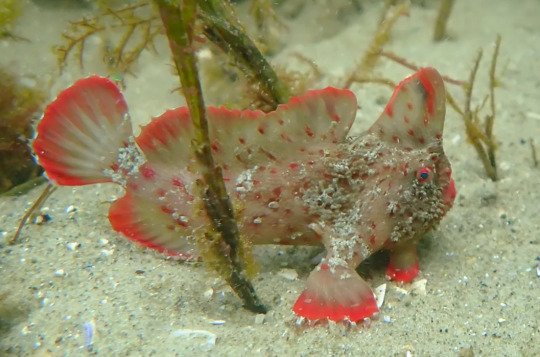
“Conservationists in Australia are celebrating the return of 18 critically endangered red handfish to the sea after they were taken into care at the Institute for Marine and Antarctic Studies (IMAS) in January to protect them from marine heatwaves.”
2. A rare Australian marsupial is being genetically modified to save it from extinction. Here's how
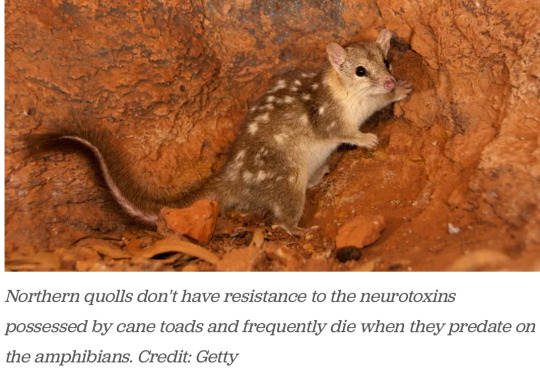
“Scientists are trying to genetically 'edit' the endangered northern quoll to make it resistant to the neurotoxin of the invasive cane toad. […] Now experts in gene-editing […] say they can introduce genetic resistance to the toxin by taking DNA from a species of South American lizard and ‘edit’ that into the cells of a northern quoll. They have already managed to do this with the cells of the closely related dunnart, another endemic marsupial.”
3. More and faster: Electricity from clean sources reaches 30% of global total

“For the first time, 30% of electricity produced worldwide was from clean energy sources as the number of solar and wind farms continued to grow fast. [...] Some of [the past year’s] new demand was for heat pumps, which are an efficient way to both heat and cool buildings, and for electric vehicles. [... Last year was also] the 19th year in a row that solar was the fastest-growing source of electricity generation.”
4. Standards Established To Improve Health Care For Kids With Disabilities
“Developed by a panel of health care experts, adults with disabilities and caregivers, the plan published recently in the journal Pediatrics […] calls for providers to be trained about caring for those with neurodevelopmental disabilities, improved communication with patients and their families and proactive planning in advance of health care encounters to ensure that patients are at ease and provided accommodations.”
5. Working together to better understand Alaska’s beluga whales
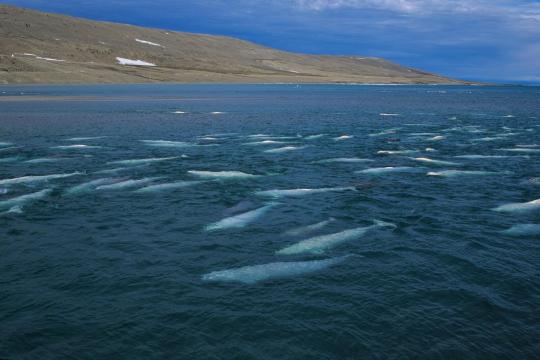
“Beluga conservation efforts depend on an accurate count of whales. Indigenous hunters also need to know how many belugas there are so that they [can] decide how many can be safely harvested. That’s why WWF is bringing together Western science and Indigenous knowledge […. U]sing hydrophones to detect belugas in the Yukon River works—and it is an approach that is both cost-effective and non-invasive.”
6. Robotic system feeds people with severe mobility limitations
“Researchers have developed a robotic feeding system that uses computer vision, machine learning and multimodal sensing to safely feed people with severe mobility limitations, including those with spinal cord injuries, cerebral palsy and multiple sclerosis. […] The robotic system successfully fed 13 individuals with diverse medical conditions in a user study spanning three locations[….] Users of the robot found it to be safe and comfortable, researchers said.”
7. Senate Passage of America’s Conservation Enhancement Act a Win for Wildlife

“The Senate’s reauthorization of the America’s Conservation Enhancement (ACE) Act will benefit America’s wildlife and way of life. Led by Senators Tom Carper (D-Del.) and Shelley Capito (R-W.Va.), the bill invests in wetlands and habitat restoration projects across the country as well as strategies to reduce conflicts between wildlife and livestock. […] The passage of this bill shows us once again that Americans are united on the need to protect wildlife and our outdoor heritage,” said Andrew Wilkins, director of land conservation policy at the National Wildlife Federation.”
8. Liberals and conservatives differ on climate change beliefs--but are relatively united in taking action
“The study, led by researchers at New York University, finds that when given the opportunity, liberals and conservatives take action to address climate change at roughly the same levels -- and that this is due to conservatives choosing to take action despite their climate-change beliefs rather than liberals failing to act on theirs.”
9. Democratic state attorneys general are teaming up to protect abortion access

“A group of Democratic attorneys general are working to strengthen state-level protections for abortion, contraception and gender-affirming care. These protections could include expanding the use of so-called “shield laws,” which assert that states where abortion or gender-affirming care are legal won’t cooperate with out-of-state efforts to prosecute anyone who helped provide treatment.”
10. Antwerp gives residents free trees

“The Belgian city of Antwerp has 2,000 trees to give away, and it wants to give them to residents to plant in their gardens [...] with the aim of involving citizens in the greenifying process of the city. [...] What’s more, the city website offers practical advice on how to proceed with planting and caring for the tree so that it will meet the standards set by the municipality. [...] The City makes sure to give dead trees a second life by using their wood in the making of natural kids’ playgrounds.”
May 1-7 news here | (all credit for images and written material can be found at the source linked; I don’t claim credit for anything but curating.)
#good news#hopepunk#fish#australia#endangered species#marsupial#gene editing#toad#electricity#clean energy#solar#solar energy#wind farm#wind energy#healthcare#disability#disabled#neurodivergent#alaska#alaska native#native#beluga#robots#wildlife#habitat restoration#politics#climate#climate change#abortion#abortion rights
18 notes
·
View notes
Text
why are so many antarctic books so hard to get a hold of like i want to read ninnis’s journal but not this much

#out of print. nothing on libgen nothing on archive.org#there’s some books by frank debenham i’ve been trying to track down and it’s the same#agh.#(circus music starts)#🗺️
18 notes
·
View notes